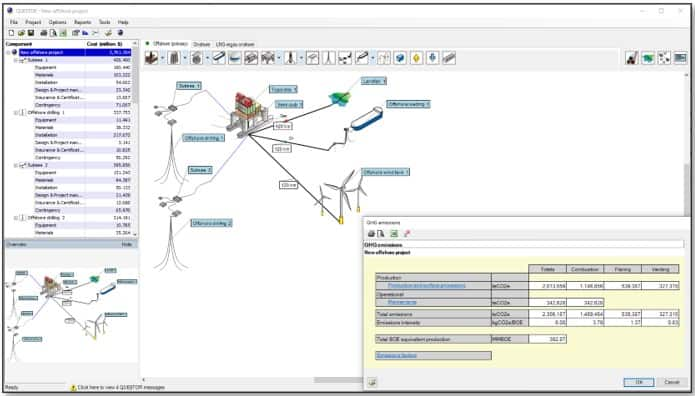Customer Logins
Obtain the data you need to make the most informed decisions by accessing our extensive portfolio of information, analytics, and expertise. Sign in to the product or service center of your choice.
Customer Logins
BLOG
Apr 28, 2023
Tracking upstream GHG emissions: reducing carbon footprint with QUE$TOR™
QUE$TOR™ enables oil and gas operators to estimate greenhouse gas (GHG) emissions, identify major sources, and optimize design for efficiency and sustainability. This is critical for reducing the upstream industry's carbon footprint in response to growing demand for sustainability from investors, regulators, and consumers.
The urgent need to address climate change has led to a growing demand for accurate estimation, reporting, and benchmarking of GHG intensity of upstream oil and gas portfolios. This information is essential for assessing carbon intensity, which has become a standard industry factor for determining the technical limits of oil and gas fields. Estimating GHG emissions is critical for both onshore and offshore upstream oil and gas developments, as it allows companies to track their carbon footprint and understand the environmental impact of their operations. In today's world, where investors, regulators, and consumers are pressuring companies to reduce their carbon emissions and transition towards a more sustainable energy future, having access to this data is increasingly important.
Incorporating GHG emissions estimation as a dynamic report in QUE$TOR™ (as shown in the image below) enables oil and gas operators to identify at an early stage the major sources of emissions in upstream projects, compare alternative designs, and make well-informed decisions to minimize their carbon footprint. QUE$TOR™ estimates GHG emissions at the project and activity level, including individual sources such as combustion, flaring, venting, and fugitives. These estimates include the most significant direct production and surface processing-related emissions, as well as indirect emissions from operational support activities. Individual emission factors can be easily adjusted or removed to accommodate specific project requirements. By having access to this comprehensive data, operators can identify areas where emissions are occurring and evaluate alternative designs or potential measures to reduce them, such as optimizing fuel gas requirements, reducing diesel consumption of facilities and support vessels, or implementing low-carbon technologies. This integration of GHG emissions estimation within QUE$TOR™ can help oil and gas companies make comparisons between projects, take data-driven decisions and work towards a more sustainable future.

By providing a structured GHG emissions report, QUE$TOR™ can help operators manage their regulatory and compliance obligations, as more and more countries introduce carbon pricing mechanisms and emissions reporting requirements. Early stage GHG emissions estimates are also important for stakeholders who want to invest in environmentally responsible projects or require carbon footprint data for their sustainability reporting.
Overall, incorporating GHG emissions estimation into our upstream cost estimation software QUE$TOR™ is a critical step towards reducing the carbon footprint of the oil and gas industry. By using this information to make informed decisions, operators can optimize their design and operations for both efficiency and sustainability, helping to create a more sustainable energy future for all.
To ask questions, see a demo and learn more about QUE$TOR™ please contact S&P Global Commodity Insights Customer Care.
This article was published by S&P Global Commodity Insights and not by S&P Global Ratings, which is a separately managed division of S&P Global.
{"items" : [
{"name":"share","enabled":true,"desc":"<strong>Share</strong>","mobdesc":"Share","options":[ {"name":"facebook","url":"https://www.facebook.com/sharer.php?u=http%3a%2f%2fwww.spglobal.com%2fcommodityinsights%2fen%2fci%2fresearch-analysis%2ftracking-upstream-ghg-emissions-reducing-carbon-footprint-with.html","enabled":true},{"name":"twitter","url":"https://twitter.com/intent/tweet?url=http%3a%2f%2fwww.spglobal.com%2fcommodityinsights%2fen%2fci%2fresearch-analysis%2ftracking-upstream-ghg-emissions-reducing-carbon-footprint-with.html&text=Tracking+upstream+GHG+emissions%3a+reducing+carbon+footprint+with+QUE%24TOR%e2%84%a2+%7c+S%26P+Global+","enabled":true},{"name":"linkedin","url":"https://www.linkedin.com/sharing/share-offsite/?url=http%3a%2f%2fwww.spglobal.com%2fcommodityinsights%2fen%2fci%2fresearch-analysis%2ftracking-upstream-ghg-emissions-reducing-carbon-footprint-with.html","enabled":true},{"name":"email","url":"?subject=Tracking upstream GHG emissions: reducing carbon footprint with QUE$TOR™ | S&P Global &body=http%3a%2f%2fwww.spglobal.com%2fcommodityinsights%2fen%2fci%2fresearch-analysis%2ftracking-upstream-ghg-emissions-reducing-carbon-footprint-with.html","enabled":true},{"name":"whatsapp","url":"https://api.whatsapp.com/send?text=Tracking+upstream+GHG+emissions%3a+reducing+carbon+footprint+with+QUE%24TOR%e2%84%a2+%7c+S%26P+Global+ http%3a%2f%2fwww.spglobal.com%2fcommodityinsights%2fen%2fci%2fresearch-analysis%2ftracking-upstream-ghg-emissions-reducing-carbon-footprint-with.html","enabled":true}]}, {"name":"rtt","enabled":true,"mobdesc":"Top"}
]}


